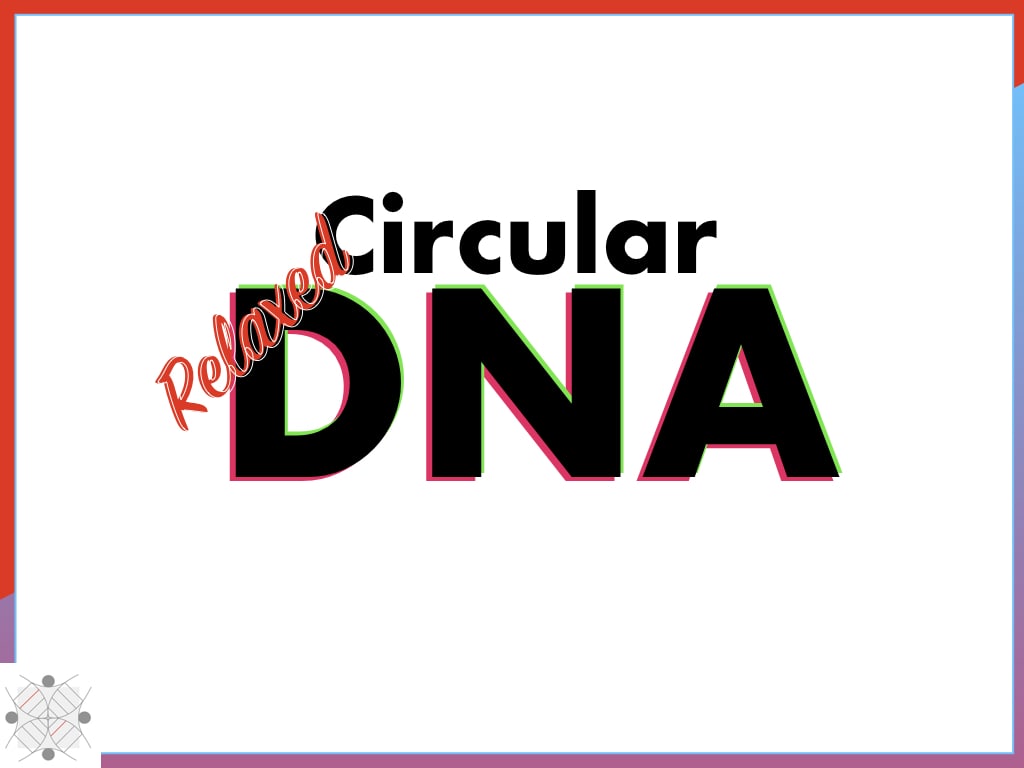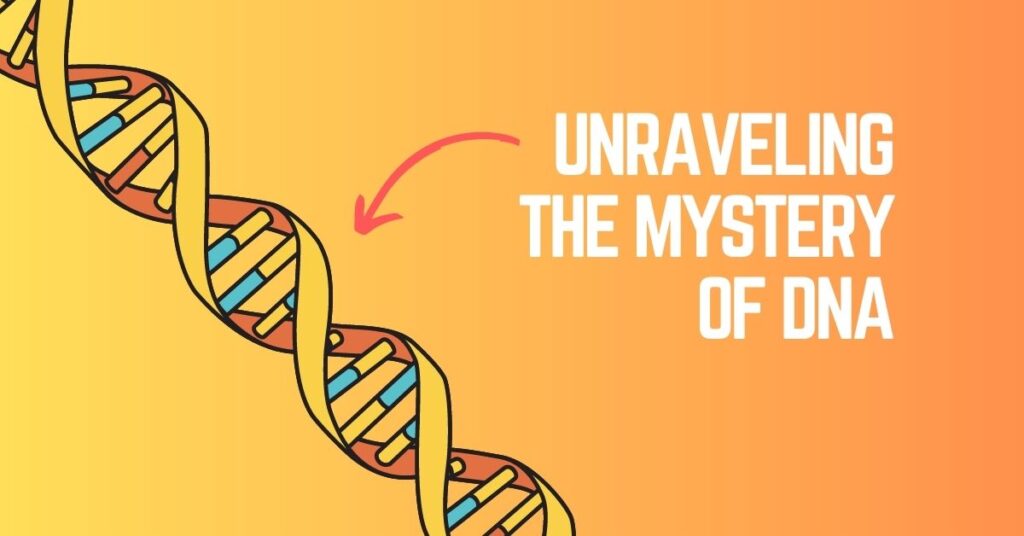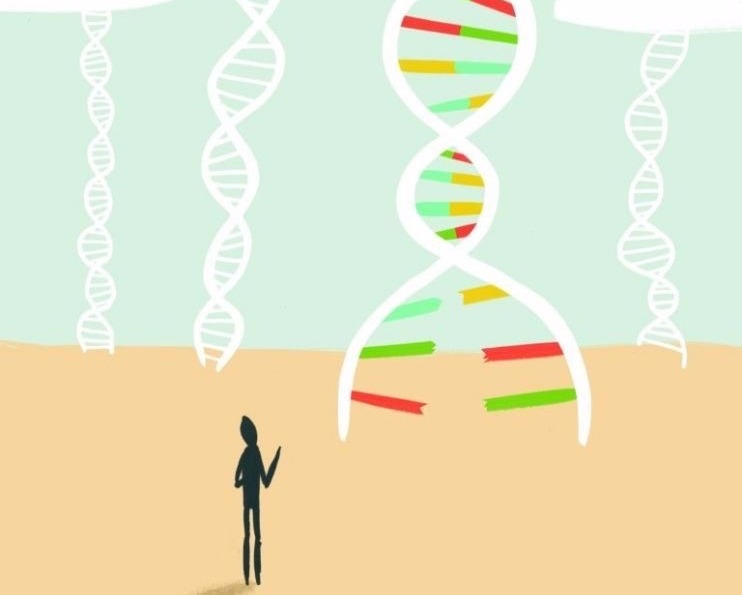“Two common circular forms of DNA are relaxed circular (rc)DNA and covalently closed circular (ccc)DNA. Let us see how both are different and which organisms possess such DNA.”
DNA has many forms.
Supercoiled and relaxed DNA forms are perhaps known, popular terminologies and very well studied. The liner DNA is still a bit acknowledged, however, topics like relaxed-circular or closed-circular DNA are still less recognized.
The term rcDNA was anonymous to me until now, however, I know much about the covalently closed circular DNA. Recently, while working on the Hepatitis B virus project, I learned about rcDNA.
Out of curiosity I searched on Google and came to know that there is less literature covering this topic. I was shocked.
It was an important form of DNA and getting into an important conversation for HBV and might be for other related viruses as well. So with the ongoing project, I started searching about it on other sources, forums, asked other colleagues, and even read books.
It’s our client’s project, and I and my team learned and wrote every possible thing about HBV and also learned about the rcDNA, its significance and how it is different from the cccDNA.
And I am ready with the answer.
In the present article, I will explain, obviously, such a diverse type of DNA with its clinical importance and why it exists in nature. But the main highlight of this content would be the differences between the rcDNA and cccDNA.
But let’s just first start by introducing the circular DNA.
Related article: DNA (Deoxyribonucleic acid): Definition, Structure, Function, Evidence and Types.
Stay tuned.
Key Topics:
What is circular DNA?
Circular DNA is either single or double-stranded DNA with sealed ends. The 5’ end of one strand is ligated with the 3’ end of its own and vice versa.
It shows a lower-level genome organization and lacks supercoiling as it usually is very tiny and contains fewer genes. It often contains a few nuclear proteins too.
It is present in eukaryotes and prokaryotes. Organelles of higher organisms like mitochondria and chloroplast have their own circular DNA but the nuclear genome lacks it. In bacteria, it is present as cytoplasmic plasmids and a nuclear (circular) chromosome. Some viruses often contain various forms of circular DNA.
Circular DNA is present in two forms, one a common and most prevalent cccDNA and another less known and unusual rcDNA.
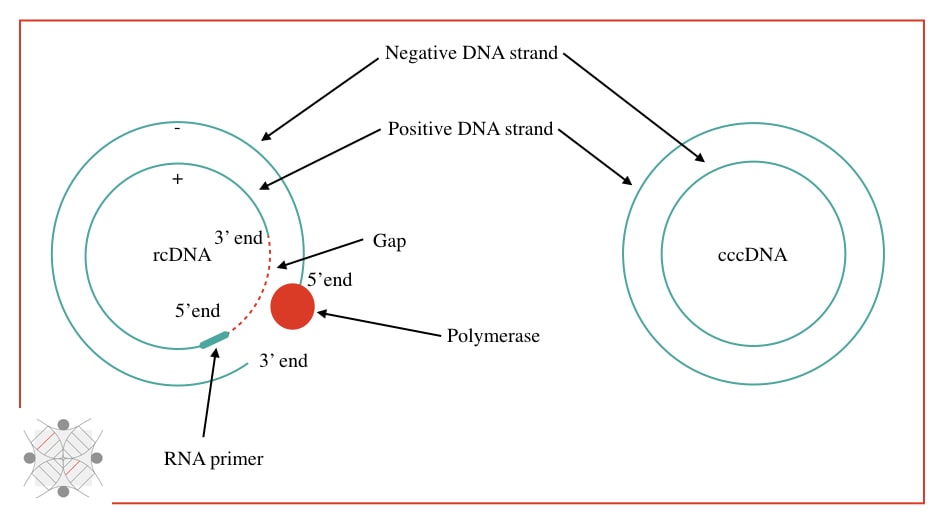
What is rcDNA?
rcDNA stands for relaxed-circular DNA, usually found in viruses, but not in humans. Put simply, it is a circular and double-stranded DNA but presents in the genome in a ‘relaxed’ form which provides stability to the host virus.
However, it should convert into an active form to spread. HBV (Hepatitis B Virus) consists of well-studied rcDNA in the form of partially double-stranded nucleic acid with a discontinued positive and complete negative strand.
The atypical characteristic of the rcDNA is the presence of polymerase protein on the negative strand at the 5’ end while the presence of RNA short nucleotides at the 5’ end of the positive incomplete strand.
These two properties help to form the pre-genomic RNA using the polymerase linked with the negative strand. However, in addition, the presence of other proteins such as the DR1 and DR2 in the HBV also facilitates stability to this relaxed form of DNA.
Properties of rcDNA:
- Partially circular positive strand.
- Presence of terminal redundancy outside the negative strand.
- 5’ capping on the positive strand.
- RNA oligomers on the 5’ end of the positive strand.
- Gap on the positive strand.
- Presence of DR1 and DR2 proteins.
One important property of the rcDNA is the presence of the nick or gap at the positive strand. To understand the unusual nature of rcDNA, we also have to know about the cccDNA too.
What is cccDNA?
The cccDNA stands for Covalently Closed Circular DNA. It is double-stranded and closed end-to-end. Studies demonstrate that once the dsDNA converts into the circular covalently end-closed DNA, it forms a stable ‘Minichromosome.’
Importantly, the cccDNA doesn’t contain any discontinuity or nick which makes it even more stable and helps to replicate effectively. The minichromosome by cccDNA is also present in some bacteria as a plasmid.
Plasmids are bacterial extrachromosomal DNA that is covalently closed and circular. For HBV, it isn’t a permanent viral entity. The cccDNA is an intermediate form fabricated in the host cell from the rcDNA.
cccDNA is further processed, reverse transcribed and converted back into the viral rcDNA. And this way helps HBV to spread from one to another cell.
Properties of cccDNA:
- Completely circular and end-to-end joined.
- Colavently circular.
- Double-stranded.
- Stable.
- Unlikely to have gaps, terminal redundancy or 5’ cap.
- Interacts with the nuclear proteins and forms a minichromosome.
rcDNA vs cccDNA:
Now let us see some of the important differences between both forms and then, we will look at how the conversion from rcDNA to cccDNA occurs.
| rcDNA | cccDNA |
| rcDNA is relaxed circular DNA. | cccDNA is covalently closed circular DNA. |
| It is discontinuous, double-stranded and contains a nick or gap. | It is continuous fully circular double-stranded DNA. |
| The 5’ends of negative and positive strands have a polymerase protein and an RNA sequence, respectively. | cccDNA’s both 5’ ends are end-to-end joined by covalent bonds with 3’ ends. |
| The HBV genome is permanently packed into the rcDNA. | The cccDNA forms temporarily during the host cell infection. |
| rcDNA positive strand is discontinuous and partially circular. | Both strands of cccDNA are fully circular. |
| rcDNA converts into cccDNA by polymerase repair mechanism. | cccDNA converts into the rcDNA via pgRNA reverse transcription. |
| Relatively unstable. | Relatively more stable and forms a minichromosome. |
rcDNA to cccDNA conversion- how and why is it important?
The conversion from rcDNA to cccDNA is well-studied from the HBV life cycle, however, due to less research literature, we will discuss the process from the HBV only.
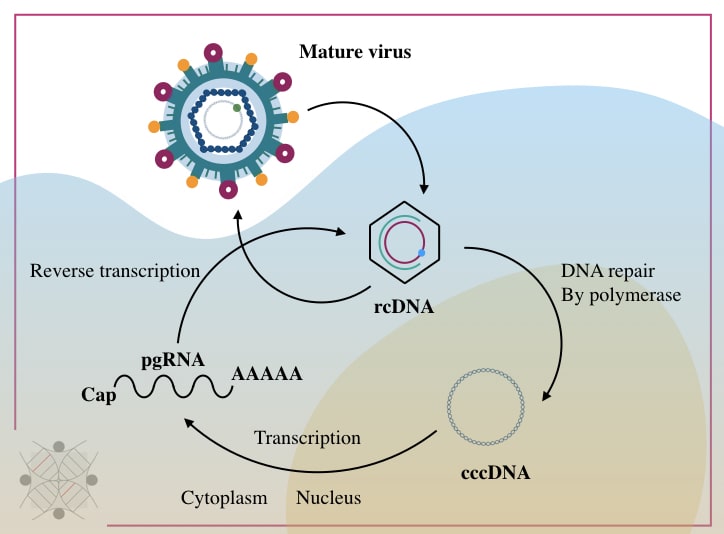
The rcDNA is first entered by surface protein HBsAg mediated internalization and released into the host cell cytoplasm. It reaches the nuclease and using the classic polymerase activity of the P protein it repairs the gaps or nicks.
It eventually converts into the cccDNA which is a fully double-stranded one. Here the RNA short oligonucleotides present on the 5’ end of the negative strand of HBV work as a primer to govern the synthesis.
Importantly, to complete circularization the terminal redundancy present outside the negative strand and the cap from the positive strand at the 5’ side must be removed. This gives signals to replicative and sealant enzymes to gather, settle and work.
In the final step, the ligase seals the gap and circularizes the entire rcDNA into cccDNA.
The fully matured cccDNA comes out from the nucleus and reverse transcribes into the pgRNA which is nothing but the pre-genomic RNA. In this conversion also, the RT-domain of the polymerase catalyzes the reaction.
The pgRNA travels back to the nucleus and is not packed into virions, forming the viral rcDNA. Some pgRNA remains unconvertable, creating a gap there in the rcDNA by forming the RNA primer and giving it a unique characteristic of partial circularization.
We will not go deep into the entire molecular mechanism of HBV replication, because the goal is to understand the concept of the rcDNA only. Now why it is important. Why does HBV do all this stuff!
Clinical significance:
Extensive clinical studies show that the rcDNA-cccDNA-pgRNA-rcDNA is an important conversion and must be required for HBV. This occurs in the host cell and eventually forms mature virion or viral particles.
Mature viruses escape the host cell and move on to other cells, thus it spreads infectivity and helps the HBV to progress aggressively into the chronic phase. We also have found shreds of evidence that the concentration of rcDNA and cccDNA often vary among different phases (acute vs chronic) and cells (serum vs hepatocytes).
Read more:
Wrapping up:
Our literature research put clarity on the incompetency of the HBV rcDNA genome to replicate directly Because it contains a gap, a cap, redundancy and non-specific RNA nucleotides that without any active conversion, can’t help the virus.
cccDNA form, on the contrary, is complete, circular and comes up as a ‘ready to replicate’ form and thus crucial form for viral infection. I think this much information is sufficient and perhaps justifies our topic.
Hope you like it. If you want to learn more, you can read these articles as well.
Sources:
- Beck J, Nassal M. Hepatitis B virus replication. World J Gastroenterol. 2007 Jan 7;13(1):48-64. doi: 10.3748/wjg.v13.i1.48. PMID: 17206754; PMCID: PMC4065876.
- Chuang YC, Tsai KN, Ou JJ. Pathogenicity and virulence of Hepatitis B virus. Virulence. 2022 Dec;13(1):258-296. doi: 10.1080/21505594.2022.2028483. PMID: 35100095; PMCID: PMC8812780.
